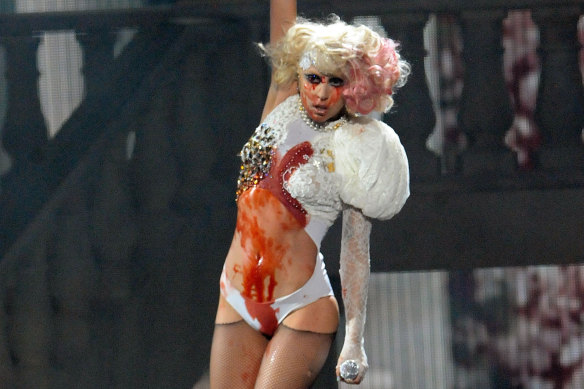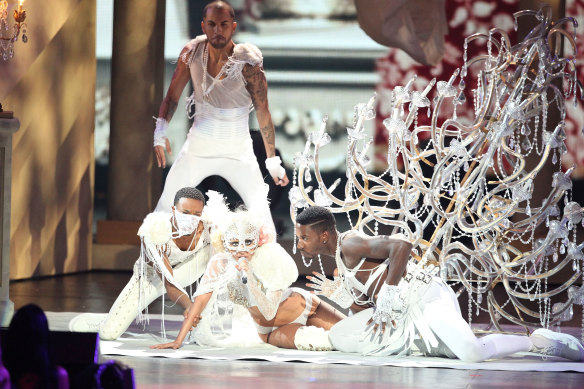History is split into two discernable eras. There’s BC, before Christ, and AD, anno Domini, a medieval Latin phrase meaning “the year of our lord” that refers to the birth of Jesus. Non-Christian historians employ the secular acronyms BCE, “before the common era”, and CE, “common era”.
Lady Gaga fans go by a different metric altogether. There is before the 2009 MTV Video Music Awards, and there is after. Cleaving history down the middle is Gaga herself, strung up by a rope, spangled with crystals and soaked in blood.
Lady Gaga’s 2009 performance of Paparazzi ended with the star suspended above the stage, covered in fake blood. Credit:Jeff Kravitz
She had just sung to a shell-shocked audience. But it wasn’t just a performance. It was an act of transubstantiation; the moment a pocket-rocket New York pop star named Stefani Germanotta really became Lady Gaga.
Ahead of this year’s VMAs on Monday, one can only dream another artist could find the courage to break the mould of anodyne, artless performances and use the moment to mark a milestone in their careers that could echo throughout pop-cultural history.
In 2009, Gaga was 23. Her innuendo-laden electropop singles Just Dance, Poker Face and LoveGame were storming the charts but she was treated as a quirky curiosity. She affected a high-pitched, Britney-style tone in her songs and interviews. The media was often condescending. Gaga was the kooky, sexed-up, fame-obsessed pop darling of the hour.
Then the curtains went up on the 2009 VMAs performance of another single, Paparazzi.
She opened with an ad-libbed prelude: Amidst all of these flashing lights I pray the fame won’t take my life…
The Britney baby voice was gone. In its place was a deep, operatic tone.
Sprawled on the floor of a crumbling baroque palace was Gaga, the bubbly, bizarre, blonde pop princess. But there was a tension in the air, a growl in her throat, a Phantom of the Opera-style fallen chandelier that bespoke tragedy.
She ditched the monotonous melody of the studio version’s chorus – I’m your biggest fan, I’ll follow you until you love me – and instead belted a melodramatic harmony that saturated the song with emotional urgency.
Gaga’s performance was inspired by The Phantom of the Opera and the demise of celebrities such as Princess Diana and Marilyn Monroe.Credit:Christopher Polk
As she sobbed through the final chorus, the crystals bejewelling the breast of her bodysuit darkened. Rivulets of fake blood streamed down her bare belly, splattering her fishnets. Underneath the music you could hear the audience shriek.
Gaga ended the performance dangling above the stage, blood smeared across her torso and face, playing dead to a soundscape of snapping cameras. Legions of young queer people swore allegiance to Gaga the moment the mic dropped from her cold, fake-dead hand.
Her point on the danger of fame might’ve been proposed with the subtlety of a mallet. But the sheer thrill of her theatrics couldn’t be denied. It was daring, camp, absurd. Gaga set heel on stage as the pop flavour of the hour and left as a blood-splattered artist with something to say.
A star was born.
Two months later, Gaga released The Fame Monster, a virtuosic pop album layered with dark tones and gory, gothic themes. The bridge of Dance in the Dark paid tribute to women and girls who had fallen victim, in one way or another, to the fame monster: Marilyn Monroe, Sylvia Plath, Judy Garland, JonBenét Ramsey, Princess Diana.
She confirmed the message behind her performance in the 2017 documentary Gaga: Five Foot Two.
“If I’m gonna be sexy on the VMAs and sing about the paparazzi, I’m gonna do it while I’m bleeding to death and reminding you of what fame did to Marilyn Monroe, and what it did to Anna Nicole Smith.”
Of course, Gaga’s performance was followed by the moment that at once upstaged her and instantly proved her thesis on the pitfalls of female fame. Kanye West snatched the microphone – and the spotlight of the entire VMAs — from a 19-year-old Taylor Swift as she accepted the best female video award and delivered his infamous one-liner.
Here was the trajectory of the female entertainer writ large: we lift them up, we rip them down, and the cameras immortalise the entire melee. The stunt reportedly kyboshed a planned double-header tour between Kanye and Gaga called Fame Kills.
Although the Kanye vs Taylor moment robbed Gaga’s performance of the attention it deserved, her decision to use the VMAs to arrive as an artist still feels unique 13 years later. Too many recent awards show performances are uninspiringly pared back, or high-octane yet unimaginative rehashes of the artists’ music video.
Last year Olivia Rodrigo battled through Good 4 U on a set decorated with digital butterflies and balloons barely worthy of a 2004 Mac screensaver (nostalgia was the point, but it still looked boring). Pyrotechnics couldn’t save a pretty yet predictable performance of Star-Crossed by Kacey Musgraves. Doja Cat cut some stunning shapes and scored points for performing airborne, but it was all too stripped back to lodge itself permanently in the pop-cultural cannon.
Exceptions to the banality included The Kid Laroi’s performance with Justin Bieber, which felt like a soaring victory for the Australian music scene. Lil Nas X used a shower-block spectacular to destroy any notions of him being a one-hit wonder and triumphantly claim his place as a queer black man commanding the industry.
But gasp-inducing stunts? Pop-cultural earthquakes? Performances in which mortals transform into icons before our very eyes? It’s been too long between drinks.
Gaga nodded to another unforgettable VMAs moment as she began her performance on the floor in a lacy white costume that echoed the wedding dress Madonna wore in her 1984 delivery of Like a Virgin; an act we still talk about today.
She knew from the second the lights went up these moments have the potential to make history.
A cultural guide to going out and loving your city. Sign up to our Culture Fix newsletter here.
Most Viewed in Culture
From our partners
Source: Read Full Article

